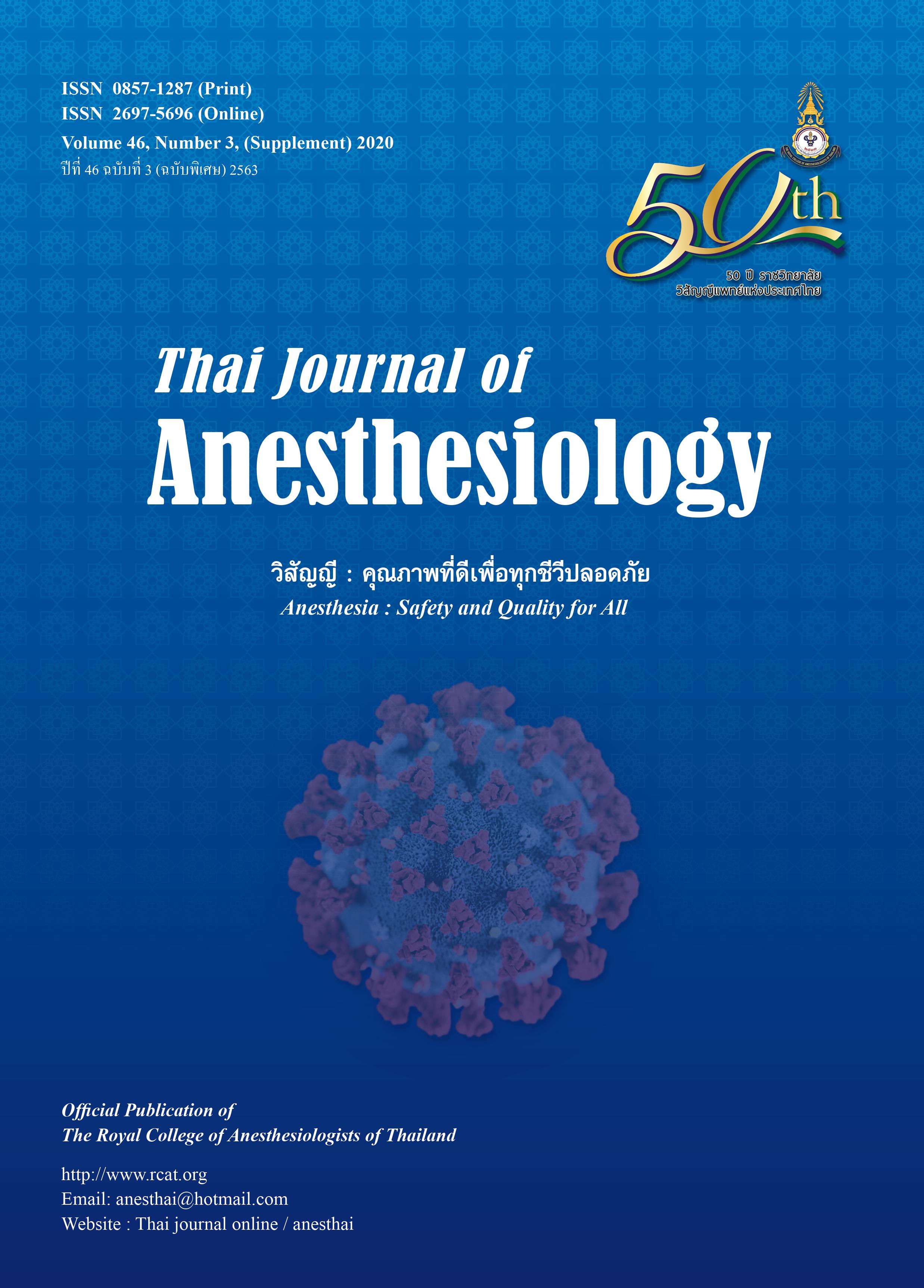Experience in Intubation by Adapted Video-assisted Laryngoscope (Laryngoscope with Endoscopic Camera)
Main Article Content
Abstract
During intubation by using a conventional laryngoscope
with a Macintosh blade, the doctor who performs this
procedure has a very high risk of contact any aerosol from
the patient. Regarding COVID-19 virus pandemic, there
are widely recommendations to use video-assisted
laryngoscope instead of the conventional laryngoscope to
avoid aerosol contact. In the context of Thailand, the usage
of video-assisted laryngoscope still limits in a tertiary
healthcare center and medical school. In order to reduce
aerosol contact from the COVID-19 patient who needs
intubation, our team develops the adapted version of a
video-assisted laryngoscope by using a conventional
laryngoscope with a Macintosh blade and endoscopic
camera. With the patients’ permission, the team performed
intubation in 15 patients for maintaining the patients’ airway
during anesthesia. The success rate of intubation in the
first attempt was 87% (13/15). Two patients have successfully
intubated in the second attempt due to the wrong technique
appliance in the first place. Besides reducing the chance
of aerosol contact by the increasing distance between the
patient and operator, the other advantages of the adapted
video-assisted laryngoscope are that it is cheap and easy
to prepare. Based on the survey questions, the operators
suggest practicing for few times before using adapted
video-assisted laryngoscope in COVID-19 patients.
Article Details
References
severe acute respiratory infection (SARI) when COVID-19
disease is suspected 2020 [Internet]. Cited 2020 Apr 15.
Available from: https://www.who.int/publications-detail/
clinical-management-of-severe-acute-respiratory-infectionwhen-
novel-coronavirus-(ncov)-infection-is-suspected
2. New York-Presbyterian, Well Cornell Medicine, Columbia
University. NYP Guidelines for airway management of
suspected or confirmed COVID-19 patients. March 23, 2020
[Internet]. Cited 2020 Apr 14. Available from: https://www.
cuimc.columbia.edu/file/44538/download?token=luHx0iV_
3. Kovacs G. COVID-19 protected intubation. Emergency
Medicine Cases 2020 [Internet]. Cited 2020 Apr 14. Available
from: https://emergencymedicinecases.com/covid-
19-protected-intubation/
4. American College of Emergency Physicians’. Royal London
Hospital COVID intubation SOP 2020 [Internet]. Cited 2020
Apr 14. Available from: https://www.acep.org/globalassets/
images/royal-london-hospital-intubation-sop.pdf
5. World Federation of Societies of Anaesthesiologists (WFSA).
Coronavirus-guidance for anesthesia and perioperative care
providers 2020 [Internet]. Cited 2020 Apr 14. Available from:
https://www.wfsahq.org/resources/coronavirus
6. Brewster DJ, Chrimes NC, Do TBT, et al. Consensus statement:
Safe Airway Society principles of airway management and
tracheal intubation specific to the COVID-19 adult patient
group. Med J Aust 2020 [Internet]. Cited 2020 Apr 15. Available
from:https://www.mja.com.au/system/files/2020-04/Preprint%20
Brewster%20updated%201%20April%202020.pdf
7. Australian Society of Anaesthetists (ASA). Anaesthesia and
caring for patients during the COVID-19 outbreak 2020
[Internet]. Cited 2020 Apr 14. Available from: https://www.
asa.org.au/wordpress/wp-content/uploads/News/eNews/
covid-19/ASA_airway_management.pdf
8. Practice advisory for preanesthesia evaluation. The Royal
College Of Anesthesiologists Of Thailand 2019 [Internet].
Cited 2020, April 15. Available from: http://www.anesthai.
org/th/files/documents/3/แนวทางปฏิบัติ
9. DoctorHouse. DIY: VDO Laryngoscope 750 Baht 2020
[Internet]. Cited 2020, April 15. Available from: https://www.
youtube.com/watch?feature=youtu.be&v=E8xNtrZKsF0&
app=desktop
10. van Zundert A, Pieters B, Doerges V, Gatt S. Videolaryngoscopy
allows a better view of the pharynx and larynx than classic
laryngoscopy. Br J Anaesth 2012;109:1014-5.
11. Xue FS, Li HX, Liu YY, Yang GZ. Current evidence for the
use of C-MAC videolaryngoscope in adult airway management:
a review of the literature. Ther Clin Risk Manag 2017;13:831-41.
12. Hossfeld B, Frey K, Doerges V, Lampl L, Helm M. Improvement
in glottic visualisation by using the C-MAC PM video
laryngoscope as a first-line device for out-of- hospital
emergency tracheal intubation. Eur J Anaesthesiol 2015;
32:425-43.
13. Asai T, Matsumoto S, Fujise K, Johmura S, Shingu K.
Comparison of two Macintosh laryngoscope blades in 300
patients. Br J Anaesth 2003;90:457-60.
14. Jephcott A. The Macintosh laryngoscope. A historical note
on its clinical and commercial development. Anaesthesia
1984;39:474-9.


